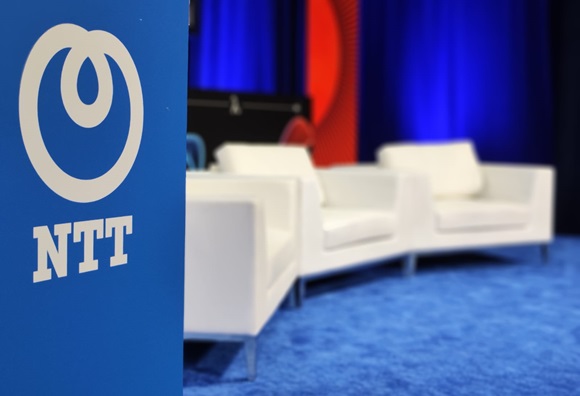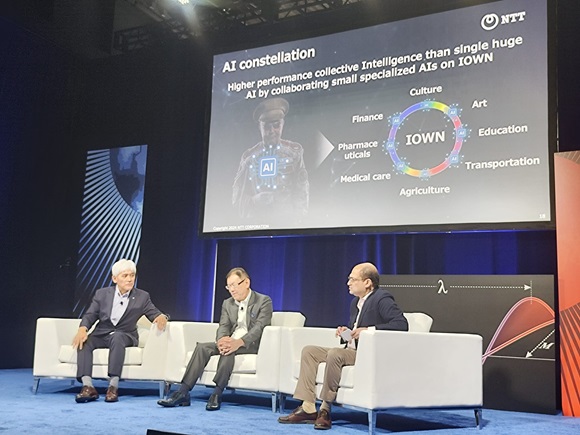NTT Research ‘Upgrade’ 2024: Live report
The Computer Weekly Developer Network team packed its bags, put some flowers in its hair… and headed to San Francisco this week for NTT Research’s Upgrade 2024.
This two-day event was designed to analyse enterprise software and cloud technology innovations around privacy, precision medicine, optical devices and the digital workplace.
As always with NTT, the conference featured a strong element of hands-on demonstration setups (some working products, some at the applied prototype stage and some even more embryonic), all of which were on show at the NTT Experience Center (XC) and the San Francisco Metreon this April 2024.
NTT Research president and CEO Kazuhiro ‘Kazu’ Gomi (aka Gomi-san) spoke to press and analysts at a pre-show press conference to explain what the event title really means.
“This event is NTT Research Upgrade, but in full we call this event ‘Upgrade Reality’ because we want to explore the processes and technologies we will now develop to upgrade our reality-based perception of where we are today in key areas – and those fields encompass unsustainable energy consumption, data and personal privacy issues, the rising costs of medical care in an ageing world population and so much more,” said Kazu Gomi, speaking with positive assertion in San Francisco this month.
We know that NTT has also made much of its own proprietary, lightweight Large Language Model (LLM) known as tsuzumi (named after the Japanese drum of the same name) which has now been enhanced with a new visual reading technology that enables LLMs) to understand the graphical elements and layout of documents, including diagrams, graphs and icons.
“LLMs have become capable of handling high-level Natural Language Processing (NLP) tasks with high accuracy and multimodal models, including those that integrate vision and language, are beginning to emerge,” said Kyosuke Nishida, senior distinguished researcher at NTT. “However, there remain significant challenges in comprehending documents or computer screens that contain both text and visual information, such as charts and tables.By integrating our visual reading technology with tsuzumi, NTT aims to give ‘eyes’ to AI-powered tools, unlocking new applications and functionality,” said Nishida.
First unveiled by NTT in November 2023, tsuzumi is described as an energy-efficient and low-cost LLM available in two versions: an ultra-lightweight version with 600 million parameters and a lightweight version with 7 billion parameters.
Beyond ‘traditional’ LLMs
While traditional LLMs require large amounts of power for training, NTT claims that tsuzumi’s smaller size reduces the energy consumption and costs associated with training, inference and tuning, making it (potentially at least) a more sustainable and cost-effective.
Does Gomi-san and team think that tsuzumi’s lightweight nature could see it deployed on something as small as a single server?
“Well, that’s theoretically possible, but it all comes down to the specificity that you build an LLM for,” said Kazu Gomi. “If the data inside the LLM relates to (for example) just the realm of one company’s accounts information stream, then we could be talking about that kind of smaller size footprint. But what really also matters now is the process of reducing AI bias and our research team is working on this to understand the ‘process of decision making’ in AI models. When we can pinpoint decision processes more accurately, then we can track back to the point at which AI has introduced bias based on any given set of data – and then, at that point, we can remove that data or replace it with other accurate validated information. This is part of the goal and there is much to do.”
The NTT Group plans to launch commercial services using ‘tsuzumi’ as of now in 2024 and is pushing forward with research and development on ‘tsuzumi’ to create new value by adding further multimodality.
NTT Upgrade 2024 keynote
Speaking at the NTT Upgrade 2024 keynote itself, Gomi-san reminded us that NTT invests some 30% of its profits into R&D. He feels that this event is staged in a way that engenders plenty of networking, this is crucial of course because even the top brass at NTT feel that the whole process of ‘upgrading reality’ is something that takes a team effort across departments, across entire organisations and across industry partners throughout the whole IT trade.
NTT Research’s chief marketing officer welcomed a group on stage to discuss health-tech advancements. Junaid Bajwa, chief medical scientist at Microsoft Research was joined by Joe Alexander Jr, director of the MEI lab (and also of Johns Hopkins University School of Medicine) at NTT Research and Kenjo Sungawa, director of circulatory system research at Kyushu University, Japan.
Speaking to the reality of how few healthcare professionals there will be to serve our expanding and ageing population in the immediate future, Alexander thinks that reducing the cost of care and improving patient experience goes hand in hand with improving healthcare equity (to provide health services for those that can’t afford them) – and these are some of the prime drivers behind why NTT has been building a digital twin unit that creates a picture of a person’s heart when they need cardiovascular treatment. The bio-digital-twin ‘ages’ with the human in the sense that it evolves its state as it experiences more data events during a patient’s treatment with this technology – known as the Autonomous Closed-Loop Intervention System (ACIS).
Other sessions followed designed to showcase NTT’s work (alongside partners) in the field of photonics as the company now continues to work to build what it calls the All Photonic Network (APN).
NTT’s board spent further time explaining how its 14 laboratories in Japan and 3 in the US now employ some 2300 people – all of whom are working on the ‘basic’ research (i.e. pure R&D that comes before applied practical development) that the company champions today. Spanning areas from speech recognition to quantum mechanics, optical electronics and security systems, the company is focused on research projects as an up-front flag-bearing part of the overall work of the NTT Group at the widest level.
Why does Gomi-san enjoy working in the field of research? “Because it’s cool,” he said, during keynote discussions… really alluding to the fact that there are life and world-changnig developments afoot here. “When it comes to bringing researchers together, we all have the same core fundamental idea to create the world’s best team in each area of development – and from that point, these like-minded researchers and scientist can really start to create new ideas.”
Building long-term profit out of many of these innovations appears to not always be a prevalent part of the way NTT approaches its projects – although that thought is obviously there in the medium to long term – it’s very much a case of care for society and the planet through technology.
NTT – tech for good
As an overall look and feel takeaway, while NTT of course remains a commercial company that looks to make money and make profits, a huge amount of what the organisation showcases at its annual user events appears to be aligned with the so-called ‘tech for good’ space.
With projects designed to address areas such as signal processing to understand the implications of sound, projects focused on new breakthroughs such as artificial photosynthesis (that hope to reduce carbon emissions), initiatives designed to focus on biological conversion technology to reduce ocean CO2 and applications featuring real-time 3D video reproduction using point cloud… the general feel is an upgraded reality where the world actually works better and does better too. It’s embryonic stuff in many areas and NTT is very open about the fact that much of what it ‘hopes’ to build is still in the production and development phase.
There is more to learn here and the Computer Weekly Developer Network ‘may’ be writing about not just web developers and mobile developers and cloud developers alone… one day soon we could be discussing issues relating to photonics developers too. Let’s shine a light (pun intended) on that effort.








